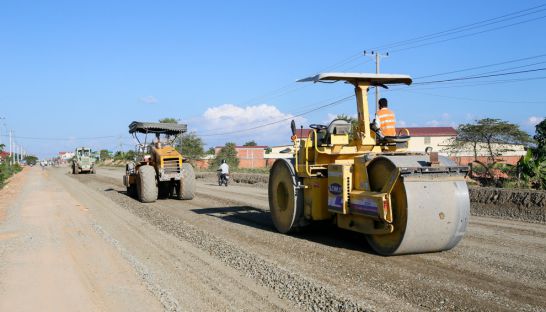ADB to muscle up its lending with pledge of $1B
ADB to muscle up its lending with pledge of $1B
Cambodia could receive over $1 billion in developmental aid and grant funding from the Asian Development Bank (ADB) in the coming four years as the multilateral financial institution consolidates its lending arms and scales up operations across the region – a move that some analysts see as a response to China’s newly-formed international lending institution.

Addressing a forum yesterday to mark 25 years since the ADB commenced activities in Cambodia, Samiuela Tukuafu, the bank’s country director, said the ADB was restructuring to meet the region’s many macroeconomic challenges, such as increasing mechanisation across traditional supply chains.
“By scaling up our operations to help meet new development challenges, [it will] improve our quality of support, and enhance development effectiveness in response to the changing needs of the region,” he said.
Tukuafu said the planned merger of the bank’s two lending arms, the Asian Development Fund (ADF) and the Ordinary Capital Resources (OCR), beginning in 2017 “will triple our equity base and allow ADB to increase assistance by almost 50 percent”.
The restructuring would increase the ADB’s total lending capacity to $20 billion per year by 2020, he said, adding that the bank was committed to being Cambodia’s leading development partner.
The ADB is Cambodia’s single largest multilateral development partner and has provided $2.65 billion in loans, grants and technical assistance – including co-financing – during the last 25 years.
According to Aun Porn Moniroth, Minister of Economy and Finance, the ADB has already allocated $872 million in loans this year, with another $13 million dedicated to technical operations.
Under its restructuring, the bank has earmarked an additional $1 billion in developmental loans and grants to Cambodia for projects that boost infrastructure development, increase agricultural competitiveness and enhance education.
“Within our framework agreement with the ADB, the bank plans to provide $1 billion for development programs in Cambodia,” he said, adding that the funds would be disbursed between 2017 and 2020.
The ADB’s expansion comes as China continues to expand its own investment and lending in the region, and is poised to increase funding of infrastructure projects through the formation of the $100-billion China-backed Asian Infrastructure Investment Bank (AIIB).
“For now, it just looks like Cambodia’s slice of the pie has increased,” said Ear Sophal, author of Aid Dependence in Cambodia: How Foreign Assistance Undermines Democracy. “And it bodes well that in only three years, it will get more than a third of the funding it received in the last 25 years.”
David Van, managing director for Cambodia of Bower Group Asia, said that while the government should welcome further ADB contribution, he remains sceptical of the bank’s $1-billion pledge.
“Committing or pledging [funds] compared to actual disbursing are two totally different concepts,” he said.
He argues that with its regional lending push, the “ADB is surely trying to catch up in infrastructure building now that AIIB made it their core funding sector.”
But whether the ADB and AIIB will complement or compete on funding remains to be seen. Sophal says both are possibilities.
“With AIIB’s first ever commitment going to Myanmar, which turns out to be a joint project with the World Bank’s International Finance Corporation and the ADB, it suggests that in some places, it can complement, while in other places it can compete,” he said. “Until AIIB announces a project in Cambodia, we won’t know for sure, but I think it’s also likely – initially at first – to go Dutch with the World Bank and the ADB. It’s a no brainer as there’s more than enough development work for everyone.”
Chan Sophal, director at the Centre for Policy Studies, said it was too early to say if the ADB and AIIB would play politics in Cambodia as the AIIB has not yet begun lending here. However, he suggested increased lending by the ADB could offer an opportunity to make loans more effective and timely.
“The ADB could do more in electricity investment, as the Chinese private investment into hydropower doesn’t seem to give a good price for electricity that is needed for industrialisation development,” he said.
Vongsey Vissoth, secretary of state at the Ministry of Economy and Finance, insisted during a panel discussion that ADB lending does not have a “political angle” and that the organisation is not a “hit-and-run” lender, but rather a long-term development partner.
However, he added that future lending would need increased monitoring and evaluation so that the government could learn from past successes and failures when it comes to fund allocation.
“The problems for [lending] are still huge and we are learning how to solve those problems,” he said. “We have built a solid partnership with the ADB and hope to build on our achievements.”
“Just like how the Cambodian government has had to change policies to stay relevant, so has the ADB,” he said.













